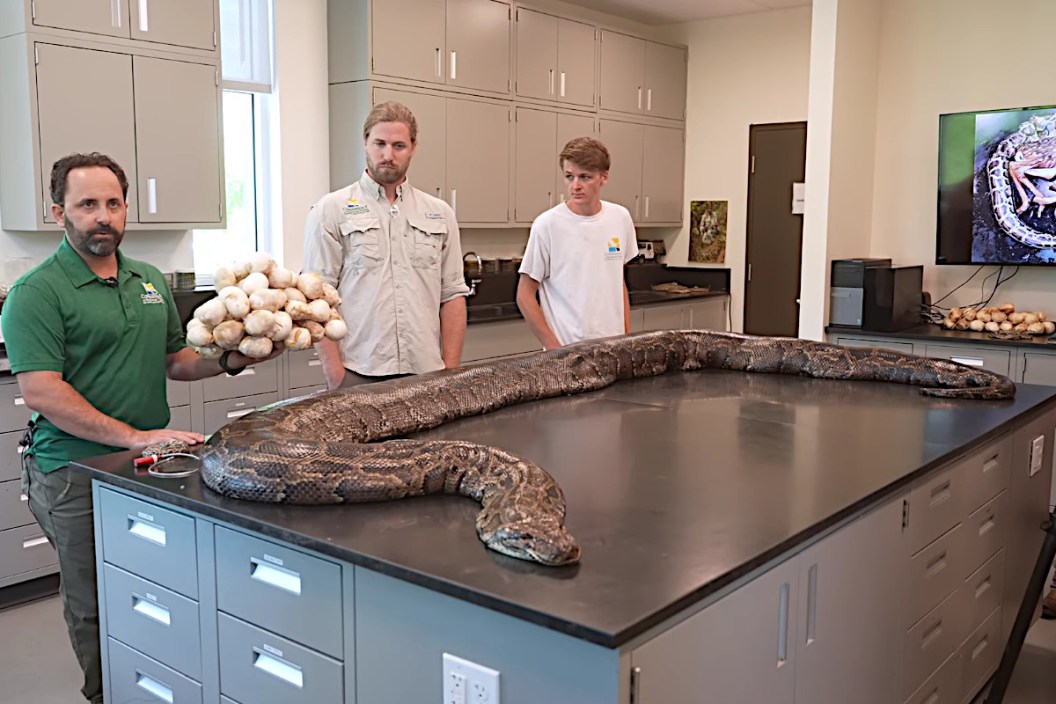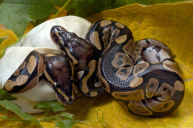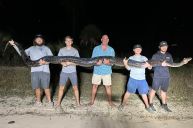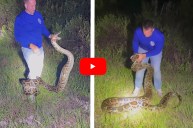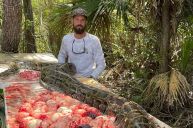Florida's python problem is getting bigger, quite literally and frighteningly. The Conservancy of Southwest Florida just announced the capture of a new record-sized invasive Burmese python. The huge snake stretched 18 feet in length and weighed a staggering 218 pounds.
When they examined her, they found a jaw-dropping 122 partially developed eggs inside.
Prior to this discovery, the largest snake ever captured by the Conservancy was a 185-pound snake. Officials say they located the huge python in the Picayne Strand State Forest. In on the capture was Ian Bartoszek, the Conservancy's Python Project Manager, biologist Ian Easterling, and their intern Kyle Findley. The group uses radio tagged male snakes to help zero in on the locations of large breeding females. They captured and euthanized this specimen back in December. The snake is estimated to be 15 to 20 years old.
"200 pounds used to always be a line in the sand for us. We used to wonder: 'I wonder if we'll ever catch a snake over 200 pounds?' This crew can tell you this snake kind of tipped the scales," Ian Bartoszek, the Python Project Manager at the Conservancy told reporters in a press conference.
Bartoszek additionally called it a "two-ton season," because the Conservancy has removed approximately 4,300 pounds worth of python from the area since November. The big snakes are a huge concern because they eat native wildlife like whitetail deer and alligators. This means the snakes are directly competing with native predators like the panther. The group has found snakes as small as ten pounds are capable of consuming fawns. In the case of this latest capture, the researchers found the remains of hooves from an adult deer.
"The last meal this animal had was a whitetail deer in Picayne Strand State Forest, this is panther food," Bartoszek, said while indicating to the hooves of the deer.
He told reporters that the state is probably past the point of eradicating the Burmese python completely from the Everglades. However, captures like this are helping the researchers to learn more about what the snakes are doing in Florida. From that, he expects they will be able to develop better python control measures in the future. The group says the python population in southern Florida may be anywhere from the tens of thousands to the hundreds of thousands.
"That's why we're doing the research. We want to understand the population, we're removing the snakes and then we're trying to figure out 'Oh, how many adult females are in this general area?' and then we can potentially hope to model the background population," Easterling said.
The researchers encouraged Florida residents who suspect they have spotted a Burmese python to contact researchers using the invasive animal reporting hotline at 1-888-IVEGOT1 or the "IVEGOT1" app so the animal can be removed.
For more outdoor content from Travis Smola, be sure to follow him on Twitter and Instagram For original videos, check out his Geocaching and Outdoors with Travis YouTube channels.
